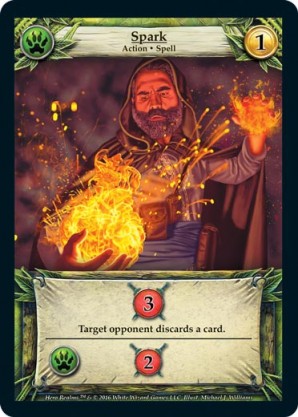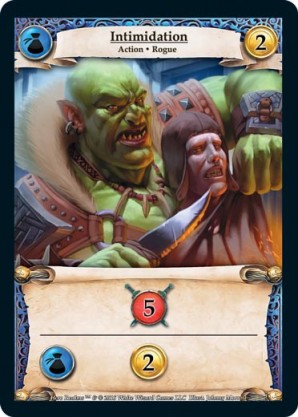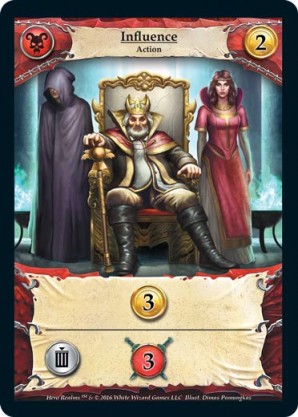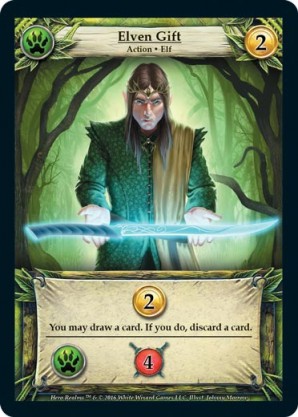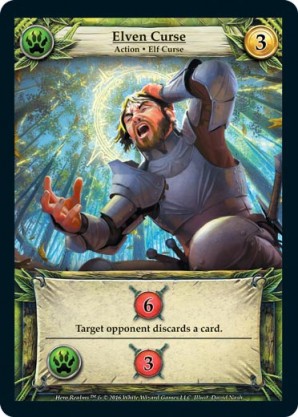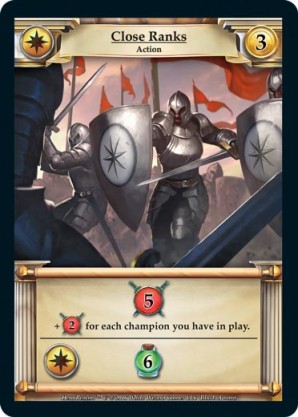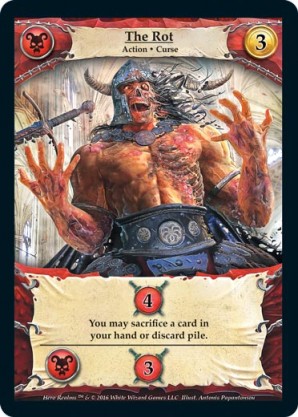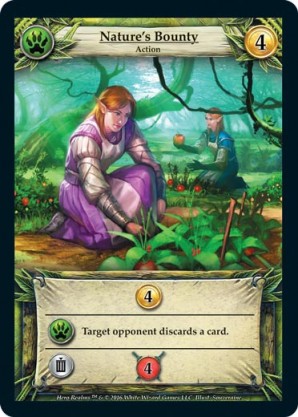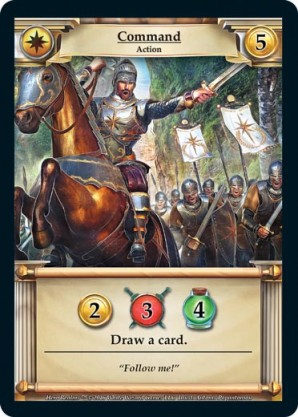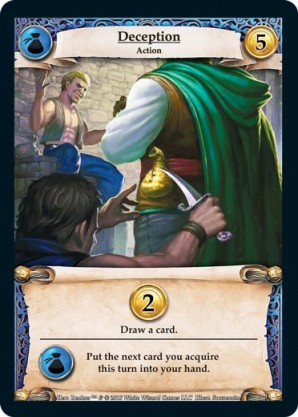The Market Row is a vital mechanic in Hero Realms. Without it we would not be able to improve our starting deck, and the game would not really be a “Deck-Builder.” We take the gold (a.k.a. economy) from the hands we draw, and we spend it on cards that appear in the Market Row. But not all cards that appear there are equal! This article is going to discuss some of the cards from the base game that have the best value. Let me start by defining what I mean by value. It ranks a card’s effect while also considering the cost to purchase that card. It is not just saying which card is the most powerful, but instead says which cards have the greatest effect at a price point. This can also be called cost performance.
Another thing to consider before we get too far is that the Hero Class being played, your opponent’s Hero Class, the game state, pace and many other factors can affect the value of cards in the Market Row. I will try to point out some situations when one Hero Class or another can get extra value out of the cards on this list, but I won’t be able to cover every possible situation. Lastly, I think that cards costing 6 or more gold, while very powerful, are not really “value cards” (and yes, this is a completely arbitrary line I made) so I won’t be talking about Fire Bomb, Domination, Rampage and the like. They have great effects, but the price point of these cards is high enough that they should be quite powerful. Analysis of those cards would make for a good article though!
Spark
Spark is a one cost Wild card that will give you three damage and make your opponent discard a card. It will faction for two more damage. There are three copies in the Market Deck.
Spark has one of the best damage per cost of the base set, at 3:1 (5:1 with faction). This card can only be matched by another card on this list, (Close Ranks, and only then when everything lines up perfectly). Damage per cost isn’t everything though, as you want higher damage regardless of cost later in the game, so the discard and faction are what make this card such a good value.
All of the Hero Classes like this card to some extent, but Thieves are especially fond of Spark. It is one of 2 cards in the base set that causes discard and costs less than 3 gold, which allows it to be top decked multiple times with Shadow Mask. With their discard skill and a couple of Sparks, that can be a bad day for their opponent.
Overall, I would usually buy a spark when I see it in the Market Row, but it’s not quite an “auto-buy.” Spark is a one cost card that is good regardless of when in the game it shows up, its value lessens as the game progresses and you can afford to buy bigger damage cards, but it’s rarely a mistake to pick this one up.
Intimidation
Intimidation is a two cost Guild card that will give you five damage and will faction for two gold. Much like Spark, it’s damage per cost is good. There are two copies in the Market Deck.
Intimidation has some solid base damage and will be a welcome draw at almost any point in the game. It has a good damage per cost (2.5:1) and it’s damage per draw is similar to cards that cost 3 gold. It is the only card at it’s price point that is focused on damage rather than having a faction or sacrifice ability for damage. Let’s say you get five shuffles in an average game (this can vary wildly based on class/matchup, so keep that in mind) that means Intimidation will normally do 20 damage in a game. It can do even more in a longer game, or if you can top deck it. That’s nothing to sneeze at! It’s faction ability gives you economy, and pairing this up with another Intimidation or Profit means you will be flush with both damage and economy! This is a great card to get later in the game, and it will help faction cards like Deception, Hit Job, Bribe, and Death Threat which have some great faction abilities.
A Fighter likes this card a lot, to just amplify their starting damage. It’s pretty good for Rangers and Wizards as they like to cycle through decks quickly and the more times you get five damage the better it is, they can also “stack” it for the faction ability more often as well. A Thief may target this with it’s shadow mask, as it has a lot of damage for being less than 3 cost. Cleric’s lack damage in their starting deck and this is a very good option for them to overcome that.
Overall, Intimidation is a good value card at two cost, but not the best one out there. It is one of the more situational “value” cards on this list, but it is still rarely a “bad” pick.
Influence
Influence is also a two cost Necros card, and it gives 3 gold as the primary effect. It has no faction ability, but can be self-sacrificed for 3 damage. There are three copies in the Market Deck.
Influence is one of three cards in the base set that gives you more economy than it costs (Taxation and Profit being the other two). The fact that it is a self-sacrifice card (when you chose to trash it) is what really makes this card great. The biggest downside to buying cards that give you economy is that at a certain point in the game you want to stop buying new cards unless they really help your deck and focus on cycling through your deck to let it dish out the damage that you need to win (i.e. the mid-late game). This card overcomes that downside by letting you trash it for 3 damage. Which you will want to do in order to keep it from clogging your draws up with economy when you really want damage.
Overall, it’s a good value card. I would place it towards the bottom of the ones I am writing about in this article, but it has situations where it can really shine. It’s a great candidate to top deck when you have some economy and don’t want to flip your deck (for details about “the shuffle” check out this article). I usually only hold onto it for 2-3 shuffles before trashing it, but I tend to lean towards a more aggro playstyle and it can be useful longer in certain situations.
Elven Gift
Elven Gift is my favorite card currently in the game (at least released in the digital app). It is a two cost Wild card that gives two gold and lets you draw and discard up to one card. It also factions for four damage. There are three copies in the Market Deck.
Elven Gift is a really great early buy that increases your economy and speeds up your deck. The economy is not great later in the game, but is enough to pay for your 2 cost skill if you are scrapped down. The cycling is great almost always. There are a few situations where you do not want to shuffle your deck mid-turn (the shuffle), but you do not have to use this part if you don’t want to. That makes it even better! The faction ability for 4 damage is quite solid, and since the relative strength of the wild faction is pretty high in general, you are likely to have more in your deck than just this card.
I said this was my favorite, but I don’t think it is the “best” card. There are more expensive cards that have a much greater effect, but at this price point Elven Gift is one of the cards with the best “value.” This card is especially good for Wizards, Rangers and Thieves. Clerics and Fighters love it too, but the fact that it is an action and cycles lets the other three Hero Classes take extra advantage of it.
Elven Gift is pretty much an auto-buy unless you are in the very last stages of your game. Even then it can still be great, but is more situational and might not help your deck.
Elven Curse
Elven Curse is a three cost Wild card that gives you six damage and makes your opponent discard a card. It factions for three more damage. There are two copies in the Market Deck.
Elven Curse is like Spark but bigger and better. It does the same thing as Spark but moreso. The damage per cost is a little less, while the damage per draw is higher and they synergize well. Elven Curse is a lot of damage for a card you can regularly buy turn 1. This is a card you want to buy at any point in a game. Unlike Spark, the damage here is high enough that it is a great late game buy. In fact, it is pretty much an auto-buy unless your other options are something like Fire Bomb or Rampage.
Thieves love Elven Curse even more than Spark, and it is a good buy for any class and is solid at any point in the game.
Close Ranks
Close Ranks is a three cost Imperial card that gives you five base damage and an additional two damage for every champion you have in play. It factions to heal six damage. There is one copy in the Market Deck.
Close Ranks has the highest possible damage ceiling of any card currently in the game. It requires a number of champions to achieve this, but can easily do 11+ damage with the theoretical limit being 79 damage (this would require you to have every champion in the market deck and be playing a cleric with three champions in your starting deck), I have seen this card do 25 damage (and I am sure there have been instances of it being higher). Even the base five damage is solid but not great for it’s cost. The six heal is a very good faction ability. It only takes a champion or two to be a really great value.
Close Ranks is an ideal card for Clerics, and can be great for the other Hero Classes. It synergizes with a Cleric starting deck and makes their strengths even stronger. A Thief that has a few champions can Shadow Mask this to get extra value out of it!
Close Ranks gets better as the game progresses and you get more champions (or Imperial cards to faction). This is usually an auto-buy even if the reason is to keep your opponent from getting it.
The Rot
The Rot is a three cost Necros card that gives you four damage and lets you sacrifice a card from your hand or discard pile. It factions for three additional damage. There are two copies in the Market Deck.
The Rot is a very solid card. It has decent damage (though the damage per cost is lower), but the sacrifice is what makes this card valuable. The faction ability for additional damage can make this a very solid damage card when you line that up.
To really understand the value of this card, I need to discuss the sacrifice mechanic and how it operates. It allows you to remove weaker cards from your deck so that you increase your chances of having stronger draws as the game progresses, but it is not a quick process. It is amazing if you expect a longer game, but not so much for a shorter one. If you buy a card with sacrifice in deck one, it will be included in your first shuffle and put into deck two. In deck two you can use the ability to remove a card from your hand/discard, so the sacrifice card actually makes your deck bigger the first time you play it. Then you shuffle again, and in your third deck it basically takes the place of whatever card you sacrificed. By deck four we reach the point where your deck is thinner because of the sacrifice ability. For this to be of much value, the game needs to last at least 15-16 turns for sacrifice to really help you. A top-deck or to-hand effect will speed this up, and sacrifice cards are a great target for this sort of thing.
Clerics really like this card because they tend to take a while to ramp things up and the games go longer, so the sacrifice has a bigger impact. It will also be valuable regardless of your class when playing against a Cleric! Thieves can target The Rot with Shadow Mask and speed up the sacrifice effect (sometimes getting multiple uses before shuffling), so it is quite good for them as well. The Ranger and Wizard will cycle/draw through their decks a bit faster so it speeds up the effect, making it stronger for them. The Fighter wants a shorter game by default, so it’s less valuable to them, but can still be a good purchase if you can faction it.
Nature's Bounty
Nature’s Bounty is a four cost Wild card that gives you four gold. It factions to make your opponent discard a card, and can be self-sacrificed for four damage. There is one copy in the Market Deck.
Nature’s Bounty is a great early game buy, and can really set you up to buy some bombs. The faction ability is a nice bonus when you can get it, but the self-sacrifice is what really makes this one a value card. In most late game situations this isn’t a high priority buy like it is early on. Just like Influence, the self-sacrifice is what makes it so good. It sets you up early and won’t slow your deck down in the late game. If you have a lot of Wild faction cards it is even better, and might even be a decent buy later in the game if that is the case.
Nature’s Bounty is not particularly better or worse for one Hero Class than it is for others.
Command
Command is a five cost Imperial card that gives two gold, three damage, four healing, and lets you draw a card. It has no faction ability. There is one copy in the Market Deck.
Command is the definition of a versatile card. It is a cantrip (a card that replaces itself by drawing) so it doesn’t slow down your deck. It has economy, damage, and healing. It’s a little crazy that they designed a card that did so much without needing to faction. This is an amazing early game buy and great even in the late game. Buying this card early does not commit you to a certain plan of action, and is useful in almost any deck. It just does so much for the cost that it is hard to find a situation where you wouldn’t want to buy this card.
Command is an action that draws, and so is especially loved by Wizards and Rangers. The fact that it does so much means every Hero Class will find it useful.
Deception
Deception is a five cost Guild card that gives two gold and draws a card. It factions to put the next card you acquire into your hand. There is one copy in the Market Deck.
Deception is a unique card! The primary effects are decent, but nothing great for a five cost card. It is a cantrip, and so it does not slow down your deck. Even at a cost of five gold, it can give you an early economy boost. The faction ability is what makes this one of the most powerful cards in the game. It is the only card that will allow you to purchase a card directly into your hand (only certain versions of the Thief’s Heist ability can match this). That effect is insanely good and will absolutely win games for you. Deception is decent early in the game giving you an economy boost, but it is best in the mid-late game when you can get the big bombs directly into your hand (and play them immediately).
It is especially dangerous in the deck of a Ranger or Wizard who can set things up to faction more often than the other Hero Classes, but every Hero likes this card.
Honorable Mentions
There are a few cards that didn’t quite make my list, but were pretty close. Death Touch has the advantage of sacrifice for a very low price point, but it’s damage is not that great. If you are going for a sacrifice strategy, it’s value goes up considerably. Wolf form is a very strong five cost card, but from a value standpoint Elven Curse/Spark are similar but cheaper. It is much better later in the game when you want cards with lots of damage and you have more economy. Rally the Troops is a strong four cost card, with a damage healing combo that is essentially a ten health swing. It has a good ally ability if you have champions, but sometimes you would rather have straight just damage. It’s another that is better early, and worse later in the game unless you are deep into Imperial cards.
That covers the cards I think have the best value. You may have noticed that it was all actions. Well, champions are harder to value as they are much better if they are likely to stay out multiple turns, and worse if your opponent stuns them every round. That doesn’t mean that champions are worse than actions, their value is just more situational. There are some very powerful champions but this article focused on cost performance rather than overall power. Maybe a champion focused article would be good idea too?
I am sure some great players will disagree with at least some of my assessments. That’s okay. The Hero Classes we prefer and the natural tendencies we have will effect our views, but I would love to discuss this and hear some other thoughts. So join the Realms Rising Discord channel if you haven’t already and share your thoughts there!

